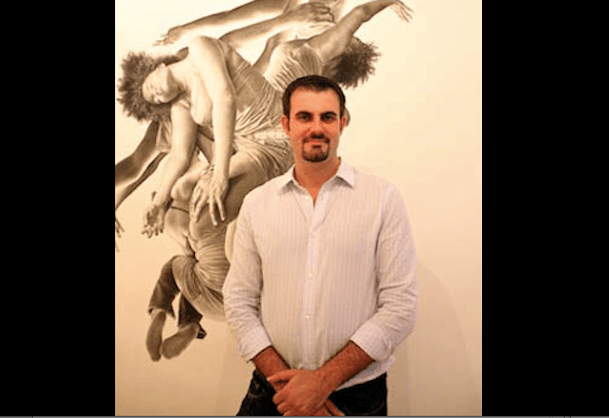NEW YORK—They were supposed to celebrate the opening of their group exhibition at Dacia Gallery on Feb. 13, but a snowstorm whited out their plans for the evening. Gathering instead a week later, the exhibiting artists who attended introduced their paintings, each one fresh off the easel.
Their audience—mostly friends and fellow artists—spilled out from a white-walled furnace of a room onto the sidewalk, filling the block with excited chatter. As the speeches began, voices dropped to a hush.
What followed was no exercise in customary self-introductions and thank-yous—artists launched straight into sharing their inspirations, musings, unresolved artistic conundrums, and working methods. They were often self-effacing, thinking out loud, backtracking, and drew peals of sympathetic laughter from their listeners.
Dacia Gallery is a sliver of a space on Stanton Street on the Lower East Side, where hundreds of galleries have sprung up over the last few years. In a landscape dominated by pop, abstract, and conceptual art, Dacia is one of a handful of galleries in the city focusing on contemporary figurative art.
The uncommonly collegial atmosphere here is bred from owner and curator Lee Vasu’s distinct vision for his gallery.
Watching Artists, Not Markets
At the most basic level, art galleries function to connect artists and collectors. How to negotiate between the interests of the two groups is up to each gallery owner. From Dacia’s inception four years ago, Vasu has tipped the balance almost completely toward the artist, and it’s working.
He actively helps artists get into other galleries.
“Not many galleries do that—‘Why would I give my artists away?’—I don’t look at it like that,” he said. “I want them to gain full exposure everywhere. It doesn’t help me or anyone else if they just have one solo show a year.”
Last year he sent the works of 27 artists on a three-month tour across France, Germany, and his native Romania. If a painting sold along the way, the buyer wasn’t allowed to have it until the whole tour concluded.
When it comes to collectors, he sometimes finds himself turning people down—not because their offers aren’t good, but because their collection might not be the best home for an artist’s work.
“I would rather sell it for a larger percentage off if I can get an artwork into an important collection because it helps the artist in the long run,” he said.
The press and auction houses can push a young artist to dizzying heights. But to ensure that an artist’s career doesn’t fizzle out with the changing fashions requires a slow and steady approach based on patronage and building relationships between artists and collectors.
Vasu said Dacia has attracted a younger group of collectors since he started showing artists in their 20s and 30s.
“All these younger people started to come check it out,” he said. “Once they’re hooked, people keep coming back. We have a good group of supportive collectors.”
A Learning Culture
The next big thing on Vasu’s agenda is a field trip of epic proportions. He’s taking applications (http://daciagallery.com/artist-in-residency.php) from artists of all skill levels for a monthlong residency in Sibiu, Romania.
They will paint and draw figures and landscapes, visit catacombs and monasteries, and study ancient frescoes. Vasu brokered a deal with the Romanian government to let his group of intrepid artists sleep in Dracula’s castle.
All participants are expected to break out of their comfort zones, Vasu said.
“How many Prussian, Serbian, Turkish, or Greek artists can the average artist in the United States name? There’s a half a continent’s worth of work that we don’t know,” he said. “My idea is to take them out there and show them something different, inspire them in a different way.”
A former art educator, Vasu has a teacher’s knack at encouraging people to explore and express their ideas.
Personal and artistic growth is always on his mind, and being an artist himself, Vasu understands that creative people thrive on constantly pushing the limits of what’s possible. He runs his business the same way—staying involved with the questions each artist is grappling with in his or her artistic expression.
“I don’t like to plan shows too far ahead because you never know what artists will be working on in the meantime,” he said.
At this moment, if there’s one thing on the minds of this group, it’s a concern about human connection, or more specifically, the problems therewith. The trend among these artists’ figural works is bodies and faces turned away from the viewer, an indirect or obscured gaze, a general sense of emotional distance. They say something about secret pains, isolation, and the modern condition.
Dacia Gallery’s current group exhibition, Motus in Figuris, closes on Feb. 28 and features the work of Erin Anderson, Janet Cook, Stephen Early, Thomas Legaspi, Stefano Losi, Osiris Rain, Biata Roytburd, Buket Savci, Carol Scavotto, Victoria Selbach, Patricia Watwood, and Thomas Wharton.
For more information, visit www.daciagallery.com






